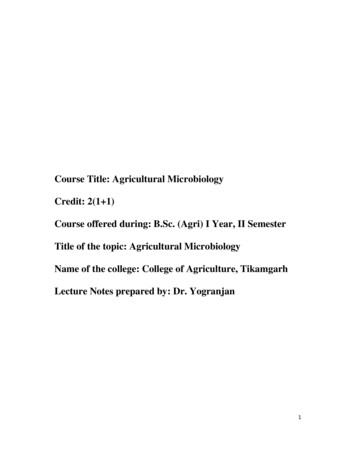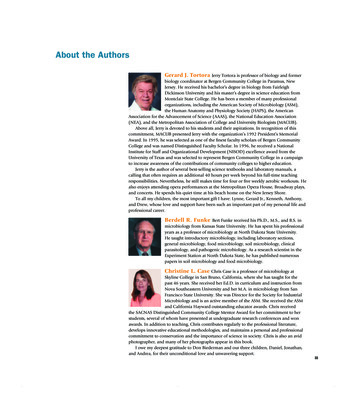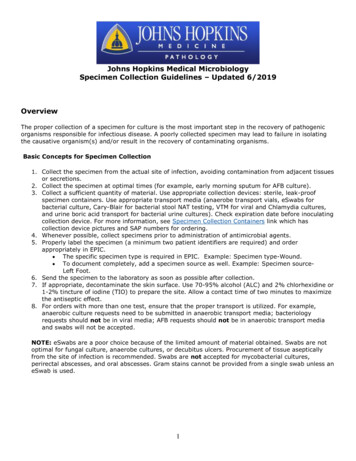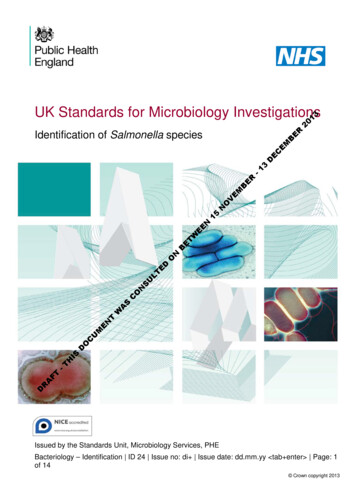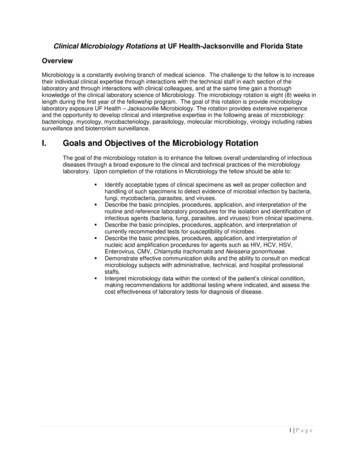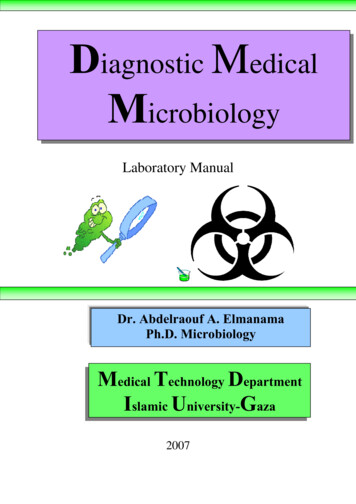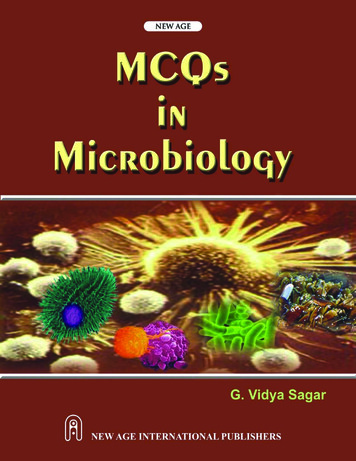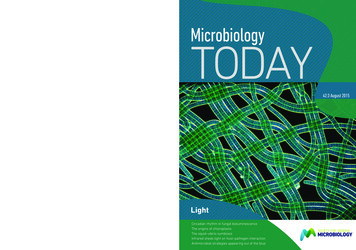
Transcription
1MEDICAL MICROBIOLOGYPathology Residents rotate for at least three months in Medical Microbiology. These rotations aredesigned to introduce the resident to Medical Microbiology and allow them to become familiar withthe routine aspects of the microbiology laboratory as well as develop expertise in microbiologydiagnostic testing, sensitivity testing and general laboratory administration. The rotations aredivided into three separate topic areas.1. Bacteria, Media, and Susceptibility Testing2. Mycology and Virology3. Parasitology and MycobacteriologyIn all microbiology rotations the resident is expected to:1. Read from appropriate sources as much as possible about the topics that come up daily in thelaboratory.2. Be available to assist the laboratory technicians in interacting with the clinicians to obtain moreinformation on a case or report and discuss results.3. Be available to read the histoplasm buffy coat slides.4. Be available to read the blood parasite slides.5. Work up all unknown specimens assigned to them6. Attend didactic sessions with the section director.7. Prepare an interesting case to present at the Clinical Pathology interesting case conference.8. Attend the weekly infectious disease conference if possible.9. Attend the monthly Infection Prevention Committee meeting if possible.Medical Microbiology I (1st month)Bacteria, Media, and Susceptibility TestingReading material:Required:Koneman EW et al. Koneman’s Color Atlas and Textbook of Diagnostic Microbiology, 6th ed.,2005.Chapter 2: Guidelines for Collection, Transport, Processing, Analysis and Reportingof Cultures from Specific Specimen SourcesChapter 16: Anaerobic BacteriaChapter 17: Antimicrobial Susceptibility TestingColor Plates (for Pathology Board preparation)Recommended:Leber, AL. Clinical Microbiology Procedures Handbook, 4th ed., 2016.- PDF available on common driveMais, DD. Quick Compendium of Clinical Pathology, 3rd ed., 2014.- Microbiology ChapterStempak9/5/2017
2Rotation Components:1. Complete the reading material above prior to the corresponding didactic sessions.2. Didactic sessions will be held approximately daily as arranged for convenience of allconcerned.3. Bench sessions: After didactic sessions, unknown cases will be worked up by theresident. Bench rotations will be arranged if there is time and as there is availability.4. Each resident will be assigned 1-2 projects during their month long rotation. Thesemay include verifications/validations, quality improvement projects, case studies(ASCP blog write up) and case presentations. These projects are expected to becompleted by the end of the month and given to the attending.5. Laboratory management module: Typically, each month involves one projectinvolving a study of laboratory management and quality improvement.6. Journal club: We will usually read one paper or group of papers and critique themtogether, and strive to apply the results to our laboratory setting.7. Final assessment: At the end of the month, a closed book, fill in the blank exam willbe taken by each resident to assess their understanding of the material covered.Objectives:Main culture types to be discussed:1.2.3.4.5.6.Blood culturesAnaerobic culturesStool culturesUrine culturesRespiratory culturesWound culturesFor each of the above culture types understand the following:1. Epidemiology of infections2. Laboratory identification, including:a. Specimen collection and transportb. Processing, media and incubation conditionsc. Organism characteristics: colony morphology, microscopic Gram stainmorphology and biochemical & other ancillary testsd. Molecular methods, as applicable3. Susceptibility testingAnti-bacterial therapiesStempak9/5/2017
3Medical Microbiology II (2nd month)Mycology and VirologyReading material:Required:Koneman EW et al. Koneman’s Color Atlas and Textbook of Diagnostic Microbiology, 6th ed.,2005.Chapter 21 MycologyChapter 23 Diagnosis of Infections Caused by Viruses, Chlamydia, Rickettsia andRelated OrganismsColor Plates (for Pathology Board preparation)Recommended:1. Mais, DD. Quick Compendium of Clinical Pathology, 3rd ed., 2014.a. Microbiology chapter2. Larone, DH. Medically Important Fungi: A Guide to Identification, 5th ed., 2011.Rotation Components:8. Complete the reading material above prior to the corresponding didactic sessions.9. Didactic sessions will be held approximately daily as arranged for convenience of allconcerned.10. Bench sessions: Omitted for virology month, since much of this testing is no longerperformed at UMMC. For mycology and serology, after didactic sessions, unknowncases will be worked up by the resident. Bench rotations will be arranged if there istime and as there is availability.11. Each resident will be assigned 1-2 projects during their month-long rotation. Thesemay include verifications/validations, quality improvement projects, case studies(ASCP blog write up) and case presentations. These projects are expected to becompleted by the end of the month and given to the attending.12. Laboratory management module: Typically, each month involves one projectinvolving a study of laboratory management and quality improvement.13. Journal club: We will usually read one paper or group of papers and critique themtogether, and strive to apply the results to our laboratory setting.14. Final assessment: at the end of the month, a closed book, fill in the blank exam willbe taken by each resident to assess their understanding of the material covered.Objectives:Mycology:Stempak9/5/2017
41. Learn the following groups of fungi:a. Yeasts (Candida spp. and Cryptococcus spp.)b. Hyaline septate moldsc. Zygomycetesd. Dimorphse. Dematiaceous molds (pigmented)f. Dermatophytes2. Understand the following for each group listed above:a. Epidemiology of infectionsb. Laboratory identification (including processing , media, incubationconditions, colony morphology, microscopic morphology & terminology andbiochemical & other ancillary tests)c. Susceptibility testingd. Anti-fungal therapiesVirology:1. Understand the basic laboratory methods of identification of viruses, including:a. Cell cultureb. Direct antigen detection (EIA, DFA, latex agglutination)c. Serology (detection of circulating antibody)d. Histologye. Molecular techniques2. Classification of virusesa. RNA vs DNAb. Enveloped vs non-enveloped3. For the following viruses (human herpes viruses, parvovirus, papovavirus,poxviruses, hepatitis viruses, orthomyxoviruses, paramyxoviruses, picornaviruses,arboviruses and the retroviridae family) know:a. Clinical presentationb. Common methods used for identificationVaccination and treatment optionsMedical Microbiology III (3rd month)Parasitology and MycobacteriologyReading material:Required:Koneman EW et al. Koneman’s Color Atlas and Textbook of Diagnostic Microbiology, 6th ed.,2005.Chapter 19 MycobacteriaChapter 22 ParasitologyStempak9/5/2017
5Appendix 1 Ectoparasites (for Pathology Board preparation)Color Plates (for Pathology Board preparation)Recommended:3. Mais, DD. Quick Compendium of Clinical Pathology, 3rd ed., 2014.a. Microbiology chapter4. Ash, LR and Orihel, TC. Atlas of Human Parasitology, 5th ed., 2007.Rotation Components:15. Complete the reading material above prior to the corresponding didactic sessions.16. Didactic sessions will be held approximately daily as arranged for convenience of allconcerned.17. Bench sessions: omitted for parasitology month, since much of this testing is nolonger performed at UMMC. For mycobacteriology, after didactic sessions, unknowncases will be worked up by the resident. Bench rotations will be arranged if there istime and as there is availability.18. Each resident will be assigned 1-2 projects during their month-long rotation. Thesemay include verifications/validations, quality improvement projects, case studies(ASCP blog write up) and case presentations. These projects are expected to becompleted by the end of the month and given to the attending.19. Laboratory management module: Typically, each month involves one projectinvolving a study of laboratory management and quality improvement.20. Journal club: We will usually read one paper or group of papers and critique themtogether, and strive to apply the results to our laboratory setting.21. Final assessment: at the end of the month, a closed book, fill in the blank exam willbe taken by each resident to assess their understanding of the material covered.Objectives:Parasitology:1. Learn bloodborne parasites (including Plasmodium, Babesia, Trypanosoma, andmicrofilaria) and methods of detection and differentiation.2. Learn the principal tissue and intestinal worms, including nematodes, cestodes andtrematodes, diseases, modes of transmission, epidemiology and methods ofdetection and identification.3. Learn pathogenic protozoa, including amoeba, ciliates, microsporidia, flagellates andsporozoa. Differentiate tissue invasive and gastrointestinal pathogens, how toidentify and differentiate pathogenic from nonpathogenic forms.Stempak9/5/2017
64. We will generally not discuss identification of vectors, e.g. mosquitoes, ticks, orectoparasites (e.g. bedbugs, lice, mites), though you will be asked about these onboards.Mycobacteriology:1. Learn the following groups of acid fast bacilli and specific examples contained ineach group:a. Mycobacterium tuberculosisb. Photochromogensc. Scotochromogensd. Non-chromogense. Rapid growers2. Understand the following for each group listed above:a. Epidemiology of infectionsb. Laboratory identification (including processing , media, incubationconditions, colony morphology, microscopic morphology & terminology andbiochemical & other ancillary tests)c. Susceptibility testingd. Therapy optionsStempak9/5/2017
Clinical Microbiology Procedures Handbook, 4th ed., 2016. - PDF available on common drive Mais, DD. Quick Compendium of Clinical Pathology, 3rd ed., 2014. - Microbiology Chapter . . a closed book, fill in the blank exam will be taken by each resident to assess their understanding of the material covered.
